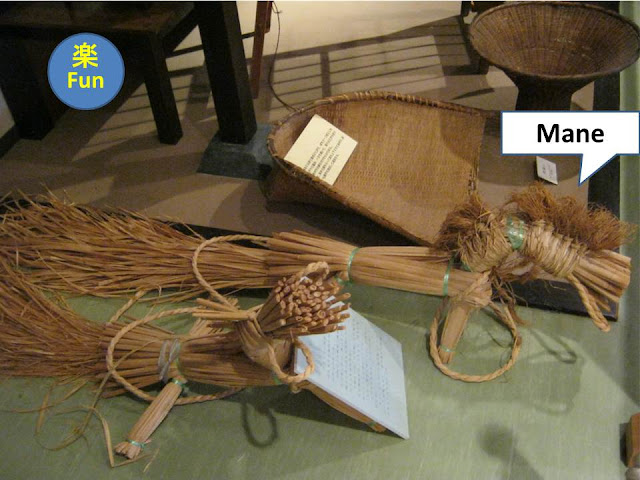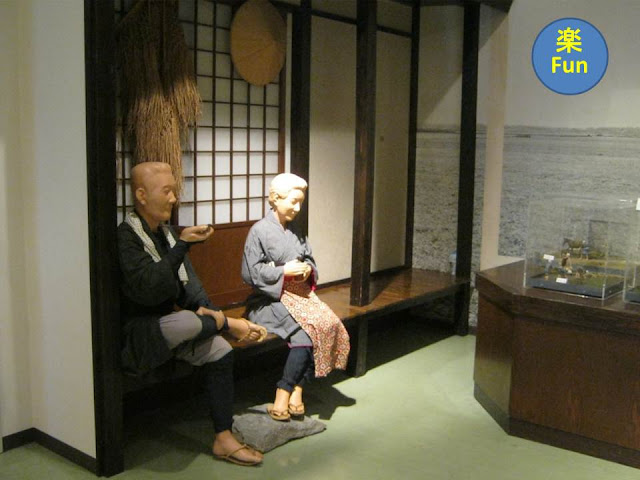This area is famous for silk-clothes called Yuki-tsumugi and wooden footwear (geta) made of paulownia
wood. Straw horses for the star festival
and the travel diary to Ise Shrine were interesting. I could see
well until the farthest mountain under the blue sky after the typhoon that day.
下総の国石下(茨城県常総市)にあり、16世紀後半に滅んだ豊田氏にちなんだ城型の交流センターの3階と4階が歴史資料館になっている。結城紬、桐の下駄を特産品としており、江戸中期に行った飯沼の干拓と新田開発がこの土地に豊かさをもたらした。伊勢旅行の行程図、七夕馬という行事に楽しみを見た。関東平野の田園地にすくっと立つ高さ約50m、7階建てのコンクリート城。若くして死んだ小説家・長塚節の像が置かれている。台風一過のこの日、富士山もうっすら見えていたが、写真には写らなかった。
 |
| View from the observatory to the East、東側の展望 |
 |
| View from the observatory to the North、北側の展望 |
The
wooden footwear (geta) made of paulownia wood is light and comfortable. We feel happy when we wear our favorite footwear. The getas below were beautiful products. The straps were fitted at the shop, so people could choose their favorite ones. The photo below shows a shoe toy.
この地の名産の桐下駄。軽くて感触が良く人気だそうだ。良い下駄を手にすると、嬉しい。写真の下段は工芸品レベル。鼻緒は小売店で付けたそうだ。ということは、鼻緒を選べたようだ。「日和」と書かれたミニチュアの下駄。シルバニヤ・ファミリーの世界だ。
 |
| Barrels and containers for Sake、樽と徳利 |
 |
| Tableware for Sake、酒器 |
Sake is Japanese local alcohol. Small sake bottles and cups were exhibited. Japanese
used same cup during the party, and people rinsed the cup as they passed the cup
to the person next them. The vessels in the lower left were used to rinse cups. Drinking with
friends is eternal fun.
酒器。これは、お金もかけられるし、審美眼が問われます。宴席で、次の人に回す前に盃をすすいだ杯洗(盃洗、はいせん)が展示されていた。今は、ひとりひとりが盃を持つので使われていない。楽しさは感じたけど、残念ながら好きな器はなかったなあ。
 |
| Horse in the star festival、七夕の馬 |
Straw
horses are made on the 7th of July which is a day of the star
festival called Tanabata. The star festival is based on the Chinese legend which celebrates
the hero and heroine of the legend (https://en.wikipedia.org/wiki/Tanabata).
Children draw the straw horses at daytime in this area. Then offer sweets and
water. In the evening, they float the horse on the river. There is an oral
tradition that the spirits of ancestors return by this horse on the first day
of Bon. The mane of this horse is made of the rice seedlings which were offered to the god at the rice planting season. I saw similar horses in Sakano’s house.
子供たちが7月7日の朝、七夕馬を連れて真菰を刈ってきたり、庭を引きまわして遊ぶ。七夕の笹竹に結び付けて、小麦饅頭や水を供え、夕方、川に流す。お盆に、先祖が乗ってくるという伝承もある。タテガミは、田植の時の苗を荒神様に上げておいたものを使用する。坂野家にもある。
 |
Farmers having a tea break. It was precious time for them.
農家の一休みの様子。ほっと一息は、嬉しい、楽しい。 |
 |
| Dyeing work of Yuuk fabric、結城紬の染め作業 |
 |
| Passport and travel diary、往来手形と旅日記 |
The map above shows the traveling
route of farmers in 1810. They visited Ise Shrine, Osaka and Kyoto. They stayed in 41 different places and traveled for 85 days. The detail was described on the
website of Joso digital museum (Japanese only). That was really great fun for them. https://trc-adeac.trc.co.jp/WJ11E0/WJJS06U/0821105100/0821105100600030/ht301320
120 people including monks gave money to the travelers as part of their customs and tradition. In return, travelers also bought souvenirs for them such as trays,
wooden sticks to transfer fire, hair-bands, towels and tobacco cases.
The travelers left Ishige on the 15th
of January. It is the last day of the New Year celebration. They arrived at Edo
on the 17th and stayed at the residence of their lord for five
nights. They left Edo on the 25th. Edo must be an attractive big
city (Life in Edo, old Tokyo) for them. They went through Nagoya and arrived at Ise on the 12th
of February, and stayed at Oshi’s house. Oshi is a priest and a travel agent of
shrines. They stayed at Ise until the 20th. They went to see the dance
offered to the Ise Gods. They enjoyed good food of course.
Their next destination was Nara. They walked
around many tourist spots in Nara, then they visited Yoshino and Kouyasan. They
stayed at Sakai on the 2nd of March, then went to Osaka. I guess they
enjoyed theater-going there. They went to Kyoto by ship, visited foundry village
in Shiga and stayed there for 9 days. It was not a tourist spot. They went to
Taga Shrine, Magome, Tsumago and reached to Zenkouji temple on the 5th
of April. They went through Karuizawa and returned to Ishige on the 11th
of April. It was really sightseeing travel. The cost of the travel was less
than 10 ryou per person, it was 5,000~10,000US$ in the
current value. Was it cheap or expensive?
石下からの農民の旅。伊勢から高野山、京を回り中山道で戻る。赤い宿泊場所が41箇所で85日間の旅である。これは楽しいわ~。展示品に関する常総市デジタルミュージアム( https://trc-adeac.trc.co.jp/WJ11E0/WJJS06U/0821105100/0821105100600030/ht301320 )の情報を以下に記載。
まず、餞別。120人から餞別をもらっており、お寺からも貰っている。餞別のお返しとしてのお土産が、盆・元結・附木・手拭いなどの日常品や煙草入を送っている。
1月15日に伊勢へ向かって出立する。江戸へは17日に到着し、江戸屋敷に5泊した後、25日に出立している。江戸に一週間、江戸は楽しいんですね(江戸生活事典)。東海道を経て2月7日、名古屋に入る。12日御師の宿に。20日まで滞在し、御閑楽(御神楽)などを見たり馳走になったりする。ここまで約一か月間。
まず、餞別。120人から餞別をもらっており、お寺からも貰っている。餞別のお返しとしてのお土産が、盆・元結・附木・手拭いなどの日常品や煙草入を送っている。
1月15日に伊勢へ向かって出立する。江戸へは17日に到着し、江戸屋敷に5泊した後、25日に出立している。江戸に一週間、江戸は楽しいんですね(江戸生活事典)。東海道を経て2月7日、名古屋に入る。12日御師の宿に。20日まで滞在し、御閑楽(御神楽)などを見たり馳走になったりする。ここまで約一か月間。
参宮を終えた一行は奈良をめざす。2月14日、奈良に入り長谷寺泊り。三輪明神、奈良の名所を見学の後、法隆寺、竜田明神、信貴山、達磨寺、当麻寺、飛鳥、橘寺、岡寺、多武峯、28日は吉野に泊る。高野山を経て、3月2日に境(堺)泊り、大坂に入る。芝居などを楽しんだのかな。14日に、伏見から京都入りする。30石船か。17日京都を出て、滋賀の鋳物師村(現朝日野村)で9日間滞在。多賀明神に参詣して関ケ原を通り木曾路に入り馬籠・妻籠を経て、4月5日に善光大門町泊り。7日軽井沢泊り、碓井峠を越えて8日高崎泊り。10日茨城県古河に泊り、11日帰宅した。伊勢参宮の名目で出立した行楽の旅である。総費用は日記の最後に「合金拾両之内」と記されている。今でいうと50~100万円。
The name of three sacred mountains in
northern Japan was written on the woven hat. People traveled(The history oftravel of Japanese ordinary people) various places mainly to visit shrines
and temples.
Terakoya was a private school for younger children in the Edo
period. Pupils learned reading, writing and calculating. Various pupils came
and learned, so it was a private lesson which depended on ability. Many pupils studied
by their own style. Some pupils just played, but I must excuse for them that
they wanted to wright their own name at least and read books.
 |
| Terakoya、寺子屋 |
 |
| Desk and Japanese abacus of Terakoya、机に算盤 |
 |
| Textbooks of Terakoya、教科書 |
寺子屋の展示があった。寺子屋には、乳幼児死亡の時期を脱した少年少女たちが来る。様々な家庭環境の子が来るせいか、子供の状況に応じた個別教授が行われていたようである。下の絵で見ると、まあ自由だ。寺子屋の様子に教科書、机とそろばん。
Invoice from the school in the Meiji period. I think it was
relentless.
明治になると、授業料取立簿。これは薄情だわ
12 funs(楽Fun)
were found. Visited in September, 2017
Official website:
http://www.city.joso.lg.jp/shigai/kanko/chiiki/1421553530228.html
(in Japanese), accessed in October, 2020
Previous post (Museum using an old house near
here) :
Next post (Museum near here) :






Comments
Post a Comment